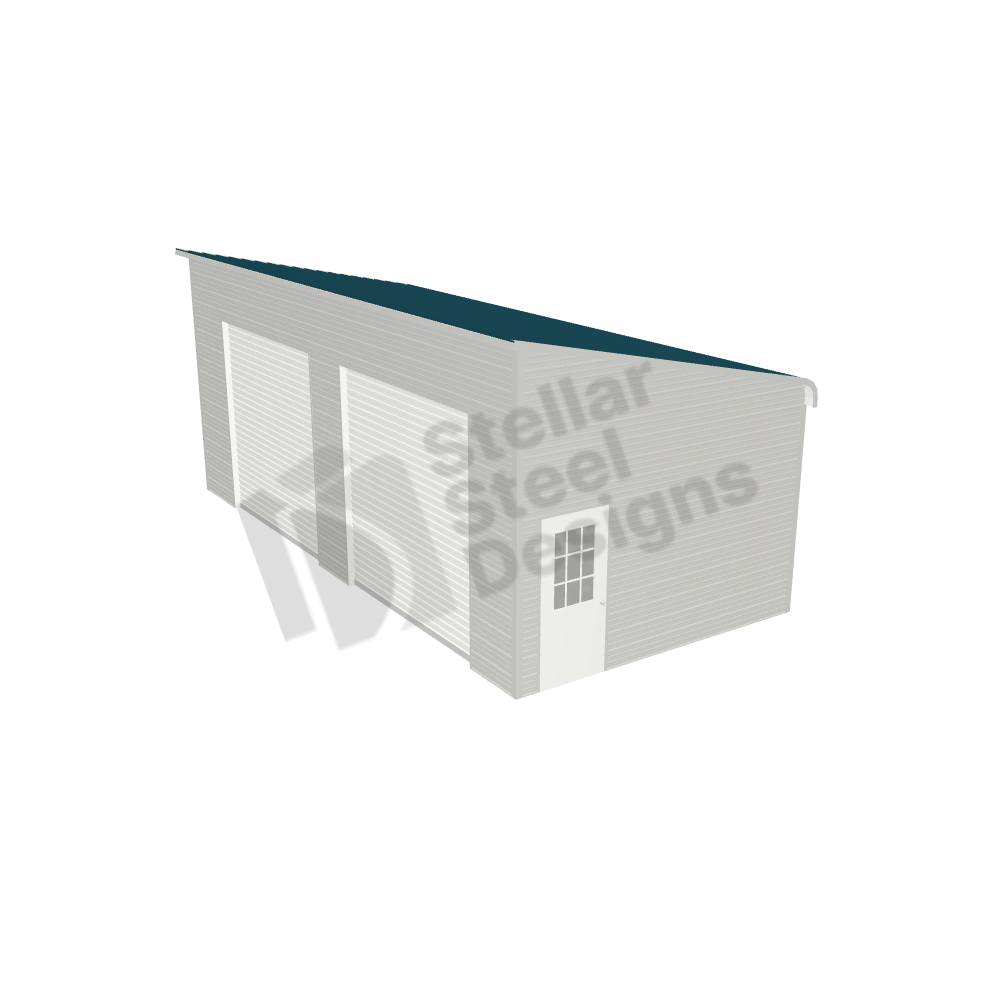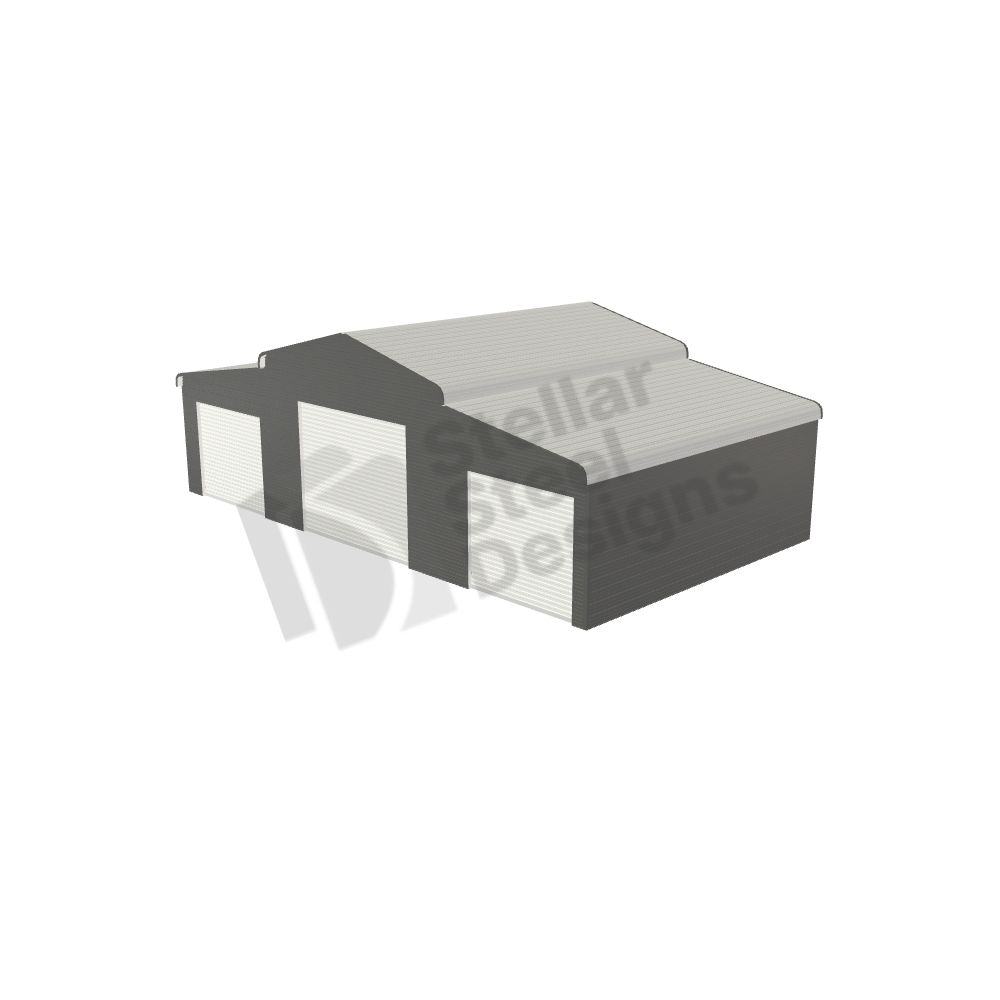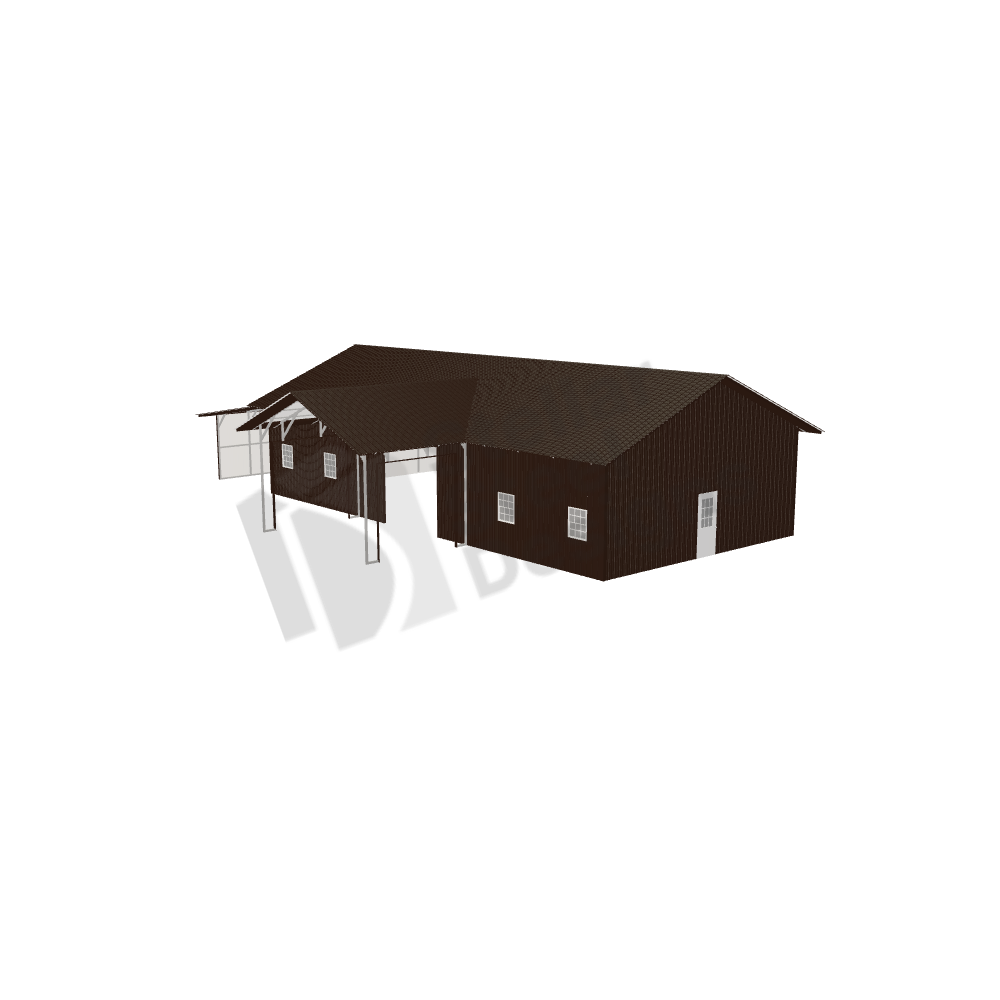What is a Free Standing Lean-To Building?
A Free Standing Lean-To metal building is a structure that typically consists of a sloping roof either on its own or attached to an existing structure . It's called a "lean-to" because it leans against the main building, sharing one of its walls. These buildings are often used as additional storage space, workshops, or covered areas for various purposes.
Why are Free Standing Lean-To Buildings so Popular?
This type of structure is popular because it's relatively easy and cost-effective to build compared to standalone buildings because it utilizes the existing structure for support. It's commonly seen in agricultural settings, industrial facilities, and residential properties where additional space is needed.
Free Standing Lean-To Building Uses
Free Standing Lean-To buildings are versatile structures that can serve various purposes depending on the needs of the owner and the design of the building. Some common uses of lean-to buildings include:
Storage
Lean-to buildings are often used for storage purposes, providing a sheltered space to store equipment, tools, supplies, or vehicles.
Workshops
Lean-to buildings are ideal structures for workshops. The covered design protects from the elements while affording plenty of space for woodworking, metalworking, crafting, or other hobbies.
Livestock Shelter
In agricultural settings, lean-to buildings are frequently used as shelters for livestock, including horses, cattle, goats, and other animals. These structures offer protection from sun, wind, rain, and snow, enhancing animal welfare.
Outdoor Dining or Gathering Spaces
In residential settings or commercial establishments like restaurants, lean-to buildings can be utilized as covered outdoor dining areas or gathering space for events and parties.
Utility Sheds
Lean-to buildings can house utility equipment such as generators, pumps, compressors, or HVAC systems. They provide a secure and weather-resistant enclosure for these essential systems.
Greenhouses
Lean-to structures can be adapted to serve as lean-to greenhouses, providing a controlled environment for growing plants, vegetables, herbs, or flowers. The sloping roof design allows for efficient drainage and ample sunlight exposure.
Parking Shelters
In residential or commercial properties, lean-to buildings can be used as parking shelters to protect vehicles from the elements, including sun, rain, hail, and snow.
Outdoor Equipment Enclosures
Lean-to buildings can house outdoor equipment such as lawn mowers, garden tools, tractors, or recreational vehicles, providing a secure and organized storage solution.
Overall, lean-to buildings offer a flexible and cost-effective option for adding covered space to a property, fulfilling various functional needs while adapting to different environments and purposes.
Free Standing Lean-To Customization
Customizing your own lean-to structure allows you to tailor the design to perfectly fit your needs, whether it's for storage, workspace, sheltering livestock, or creating a unique outdoor space. With options for materials, dimensions, and features, you can create a personalized solution that maximizes functionality and enhances your property.
What is a Garage Metal Building?
A metal garage building refers to a structure specifically designed and constructed for housing vehicles, equipment, or other items. Whether you need a basic storage space or a fully customized workshop or living space, a metal garage can be tailored to meet your specific needs and preferences.
Why are Metal Garages so Popular?
Metal garages are popular for their durability, resistance to weather elements, and relatively low maintenance requirements compared to traditional wooden garages.
Overall, metal garage buildings are a popular choice for homeowners, businesses, and organizations looking for a reliable, durable, and cost-effective solution for vehicle storage and other purposes.
Garage Uses
Metal garages are versatile structures that can serve various purposes. Some common uses of metal garages include:
Vehicle Storage
Metal garages are often used to store cars, trucks, motorcycles, RVs, boats, and other vehicles, providing protection from the elements such as rain, snow, hail, and UV rays.
Equipment Storage
They can also be used to store gardening tools, lawn mowers, bicycles, ATVs, snowmobiles, and other outdoor equipment, keeping them organized and protected from theft and weather damage.
Workshop Space
Metal garages can serve as workshops for DIY projects, woodworking, automotive repairs, and other hobbies or professional activities. They provide a sheltered and secure environment for working on projects and storing tools and equipment.
Home Gym or Fitness Center
Some people convert metal garages into home gyms or fitness centers, installing exercise equipment, mats, and mirrors to create a dedicated space for workouts and physical activities.
Additional Living Space
With proper insulation and finishing, metal garages can be converted into additional living space such as guest rooms, home offices, studios, or recreational areas, providing extra room for family members or guests.
Storage Rental
Businesses or individuals may use metal garages as rental storage units to generate additional income by offering storage space to others for storing belongings, inventory, or equipment.
Agricultural Purposes
Metal garages can be used on farms or rural properties for storing farming equipment, livestock feed, hay, and other agricultural supplies, helping to keep them organized and protected from the elements.
Garage Customization
Overall, the versatility and durability of metal garages make them suitable for a wide range of residential, commercial, and agricultural applications.
What is a Metal Barn Building?
Metal barn buildings provide shelter and protection for livestock, equipment, and agricultural supplies. However, they offer several advantages over their wooden counterparts, including durability, longevity, and low maintenance requirements.
Why are Metal Barn Buildings so Popular?
Overall, metal barns offer a reliable, durable, and versatile solution for housing livestock, storing equipment, and maintaining agricultural operations on farms and rural properties. They provide farmers with the infrastructure they need to efficiently manage their livestock and crops while ensuring the safety and productivity of their agricultural enterprise.
Metal Barn Building Uses
Metal barns serve a variety of purposes on farms and rural properties, offering versatile solutions for agricultural operations. Here are some common uses of metal barns:
Livestock Shelter
Metal barns provide a secure and weather-resistant shelter for livestock, including horses, cows, pigs, sheep, goats, and poultry. They offer protection from rain, snow, wind, sun, and extreme temperatures, ensuring the health, comfort, and safety of the animals.
Equipment Storage
Metal barns are used to store farming equipment, machinery, tools, and supplies. They offer ample space for storing tractors, plows, trailers, combines, cultivators, and other agricultural implements, keeping them organized and protected from the elements.
Hay and Feed Storage
Farmers use metal barns to store hay, straw, grain, silage, and animal feed. The spacious interior of the barns allows for efficient stacking and storage of large quantities of feed and fodder, helping to maintain their quality, freshness, and nutritional value.
Crop Storage
Some metal barns are used to store harvested crops such as grains, vegetables, fruits, and herbs. They provide a dry, ventilated, and secure environment for storing agricultural produce until it can be sold, processed, or used for livestock feed.
Workshop and Maintenance Area
Metal barns may include designated workshop areas for performing equipment repairs, maintenance tasks, and other agricultural activities. These workshops often feature workbenches, tool storage, and utility connections for powering machinery, providing farmers with a convenient space to work on their equipment.
Livestock Handling and Processing
Metal barns equipped with livestock handling facilities, such as chutes, pens, and scales, are used for sorting, loading, and processing animals for sale or slaughter. These facilities help farmers manage their livestock efficiently and safely, minimizing stress and injuries to both animals and handlers.
Event Space
Some metal barns are used as event venues for agricultural fairs, livestock shows, auctions, and other rural gatherings. Their spacious interiors, durable construction, and rustic charm make them ideal settings for hosting community events and celebrations.
Storage Rental
Farmers may rent out space in their metal barns to individuals or businesses needing storage for vehicles, equipment, household goods, or other belongings. This can provide an additional source of income for farmers while maximizing the use of their barn facilities.
Overall, metal barns play a crucial role in modern agriculture, providing farmers with essential infrastructure for housing livestock, storing equipment and supplies, and managing their operations efficiently and effectively. Their versatility, durability, and practicality make them indispensable assets on farms and rural properties around the world.
What is a Metal Residential Building?
A Metal Residential building refers to a structure designed for use as a residential dwelling. Unlike traditional homes built with wood or other materials, metal residential buildings offer several advantages, including durability, energy efficiency, and design flexibility. This makes them the perfect choice for people looking to build a new farm home, mountain cabin, or modern neighborhood home at a low cost.
Why are Metal Residential Buildings so Popular?
Metal houses are popular for several reasons:
Durability
Metal is a highly durable material, resistant to elements such as fire, rot, pests, and extreme weather conditions. Metal houses can withstand harsh environmental conditions better than traditional wooden structures, making them a popular choice for areas prone to hurricanes, wildfires, and other natural disasters.
Longevity
Metal houses have a longer lifespan compared to traditional homes. Metal is less susceptible to deterioration and decay over time, requiring less maintenance and repair work in the long run. This durability contributes to the overall value and longevity of metal houses.
Energy Efficiency
Metal houses can be designed with energy-efficient features to reduce heating and cooling costs. Proper insulation, along with reflective metal roofing materials, can help improve thermal performance and energy efficiency, resulting in lower utility bills for homeowners.
Design Flexibility
Metal allows for greater design flexibility compared to traditional building materials. Metal houses can be customized to accommodate various architectural styles, layouts, and design preferences. They offer versatility in terms of interior and exterior finishes, allowing homeowners to create unique and modern living spaces.
Quick Construction
Metal houses can be constructed relatively quickly compared to traditional homes. Prefabricated metal building components are manufactured off-site and assembled on-site, reducing construction time and labor costs. This quick construction process is advantageous for homeowners who want to move into their new homes within a shorter timeframe, all while maintaining safety as a top priority.
Sustainability
Metal houses are environmentally friendly options for housing. Metal is a recyclable material, and many metal houses incorporate recycled content into their construction. Additionally, metal houses can be designed to be energy-efficient, reducing their environmental impact over their lifespan.
Cost-Effectiveness
While initial construction costs may vary, metal houses often offer good value for homeowners in the long run. Their durability, energy efficiency, and low maintenance requirements can result in lower overall costs over the lifespan of the home. Additionally, metal houses can be a cost-effective option for those seeking a sturdy and reliable housing solution.
Overall, the popularity of metal houses stems from their durability, longevity, energy efficiency, design flexibility, quick construction, sustainability, and cost-effectiveness. These factors make metal houses an attractive option for homeowners seeking modern, reliable, and efficient housing solutions.
Why are Metal Residential Buildings so Popular?
Metal Residential Building Uses:
Single-Family Homes
Metal residential buildings can serve as single-family homes, providing comfortable and durable living spaces for individuals or families. These homes can range from compact and efficient designs to spacious and luxurious layouts, depending on the homeowner's preferences and needs.
Multi-Family Housing
Metal residential buildings are also used to construct multi-family housing units such as duplexes, townhouses, condominiums, and apartment complexes. These buildings provide multiple living units within a single structure, offering residents the benefits of shared amenities and communal spaces.
Vacation Homes and Cabins
Metal residential buildings are popular choices for vacation homes, cabins, and retreats in rural or mountainous areas. Their durability and resistance to weather elements make them suitable for remote locations where traditional construction materials may be less practical.
Accessory Dwelling Units (ADUs)
Metal residential buildings can be used to create accessory dwelling units, also known as granny flats, guest houses, or in-law suites. These smaller living spaces are often built on the same property as the main residence and can serve as independent living quarters for extended family members, guests, or renters.
Home Offices and Studios
Metal residential buildings can be converted into home offices, art studios, workshops, or hobby spaces. These detached structures provide a quiet and private environment for work or creative pursuits while still being connected to the main residence.
Storage Buildings
In addition to living spaces, metal residential buildings can be used for storage purposes. Homeowners may use them to store vehicles, recreational equipment, gardening tools, seasonal items, or household belongings, helping to declutter the main living area and organize possessions more efficiently.
Temporary Housing
Metal residential buildings can be used as temporary housing solutions in emergency situations, such as natural disasters or humanitarian crises. Prefabricated metal structures can be quickly deployed to provide shelter for displaced individuals or communities, offering a safe and secure place to stay until more permanent housing options become available.
Overall, metal residential buildings offer a wide range of uses and applications in residential construction, providing durable, efficient, and customizable solutions for homeowners, developers, and communities alike.
What is a Commercial Metal Building?
A commercial metal building is a structure typically used for business or industrial purposes. These buildings are known for their durability, cost-effectiveness, and versatility. They can range from small retail shops to large warehouses, office complexes, manufacturing facilities, and more. They offer benefits such as resistance to fire, pests, and harsh weather conditions, making them popular choices for various commercial and industrial applications.
Why are Metal Commercial Buildings so Popular?
Metal commercial buildings are popular for several reasons:
Durability
Metal buildings are highly durable and can withstand harsh weather conditions such as wind, snow, and rain. They are also resistant to pests, rot, and corrosion, making them ideal for long-term use.
Cost-effectiveness
Metal construction materials are often more affordable than traditional materials like wood or brick. Additionally, metal buildings can be constructed more quickly, saving on labor costs and reducing overall construction time.
Versatility
Metal buildings can be customized to suit a wide range of commercial and industrial applications. They can be designed with clear-span interiors, allowing for flexible use of space without the need for interior support columns.
Low maintenance
Metal buildings require minimal maintenance compared to other types of construction. They do not need frequent painting or repairs, saving time and money over the lifespan of the building.
Energy efficiency
Metal buildings can be designed with energy-efficient features such as insulation, reflective roofing materials, and daylighting systems, helping to reduce energy consumption and lower utility costs.
Sustainability
Metal is a recyclable material, and many metal buildings are constructed using recycled content. Additionally, metal buildings can be designed to be energy-efficient, further reducing their environmental impact.
Longevity
Metal buildings have a long lifespan and can last for several decades with proper maintenance. This longevity provides a good return on investment for commercial property owners.
Overall, the combination of durability, cost-effectiveness, versatility, and sustainability makes metal commercial buildings an attractive option for many businesses and industries.
Metal Commercial Buildings Uses
Metal commercial buildings have a wide range of uses across various industries. Some common applications include:
Warehousing and Distribution Centers
Metal buildings are often used as warehouses and distribution centers for storing goods and materials. Their large, open interior spaces can accommodate inventory storage, loading docks, and logistics operations efficiently.
Manufacturing Facilities
Many manufacturing companies utilize metal buildings as production facilities. These buildings can be customized to accommodate heavy machinery, assembly lines, and other manufacturing processes.
Retail Stores
Metal commercial buildings are popular choices for retail stores and shopping centers. They provide durable and cost-effective retail space that can be customized to fit the needs of different businesses.
Office Buildings
Metal buildings can be designed to serve as office complexes for businesses of all sizes. They offer flexible floor plans, energy-efficient features, and modern aesthetics for office spaces.
Agricultural Buildings
Farmers and agricultural businesses often use metal buildings for storing equipment, livestock, and crops. These buildings provide secure and weather-resistant storage solutions for agricultural operations.
Aviation Hangars
Metal buildings are commonly used as aircraft hangars for storing and maintaining airplanes, helicopters, and other aircraft. They offer large clear-span spaces to accommodate aircraft of various sizes.
Recreational Facilities
Metal buildings are used for recreational facilities such as sports complexes, gyms, indoor arenas, and community centers. They provide versatile spaces for recreational activities and events.
Educational Facilities
Schools and universities may use metal buildings for classrooms, gymnasiums, auditoriums, and other educational purposes. Metal buildings offer cost-effective solutions for expanding campus facilities.
Healthcare Facilities
Metal buildings can be adapted for use as healthcare facilities such as clinics, medical offices, and emergency care centers. They provide durable and hygienic environments for medical services.
Storage Facilities
Metal buildings are commonly used for self-storage facilities, offering secure and weather-resistant storage units for personal and commercial use.
These are just a few examples of the many uses for metal commercial buildings. Their versatility, durability, and cost-effectiveness make them suitable for a wide range of applications in various industries.




















